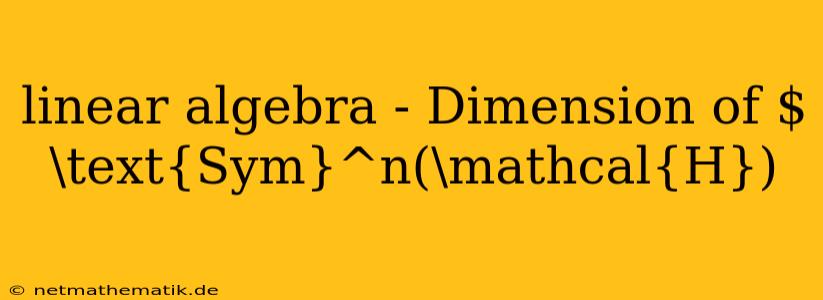Linear algebra plays a fundamental role in various fields, including mathematics, physics, and computer science. One essential concept in linear algebra is the dimension of a vector space. This article will delve into the dimension of the space of symmetric tensors, specifically focusing on the dimension of $\text{Sym}^n(\mathcal{H})$, where $\mathcal{H}$ is a Hilbert space. We will explore the significance of this dimension and its applications in different areas.
The Dimension of Symmetric Tensors
In linear algebra, a tensor is a multilinear map that takes multiple vectors as input and produces a scalar output. A symmetric tensor is a tensor that remains unchanged under any permutation of its input vectors. The space of all symmetric tensors of order n over a vector space V is denoted by $\text{Sym}^n(V)$.
The dimension of $\text{Sym}^n(V)$ depends on the dimension of the underlying vector space V. To understand this dimension, let's consider a few examples.
Examples
-
n = 1: For n = 1, $\text{Sym}^1(V) = V$ and its dimension is the same as the dimension of V.
-
n = 2: For n = 2, $\text{Sym}^2(V)$ represents the space of symmetric bilinear forms. If V has dimension d, then $\text{Sym}^2(V)$ has dimension d(d+1)/2. This can be understood by noting that a symmetric bilinear form can be represented by a symmetric d x d matrix, and the number of independent entries in such a matrix is d(d+1)/2.
-
n = 3: For n = 3, $\text{Sym}^3(V)$ represents the space of symmetric trilinear forms. If V has dimension d, then $\text{Sym}^3(V)$ has dimension d(d+1)(d+2)/6. This dimension arises from the number of ways to choose three elements from a set of d elements, taking into account symmetry.
General Formula
In general, the dimension of $\text{Sym}^n(V)$ for a vector space V of dimension d is given by:
dim(Sym^n(V)) = \binom{d+n-1}{n}
This formula can be derived using combinatorial arguments, specifically by considering the number of ways to choose n elements from a set of d elements, allowing for repetition.
Significance of the Dimension of Sym^n(H)
The dimension of $\text{Sym}^n(\mathcal{H})$, where $\mathcal{H}$ is a Hilbert space, has significant implications in various fields, including:
-
Quantum Mechanics: In quantum mechanics, symmetric tensors play a crucial role in representing multi-particle states. The dimension of $\text{Sym}^n(\mathcal{H})$ determines the number of possible symmetric states for n particles in a Hilbert space $\mathcal{H}$.
-
Quantum Information Theory: The dimension of $\text{Sym}^n(\mathcal{H})$ is essential for understanding the entanglement properties of multi-particle quantum systems. Entanglement is a key resource in quantum information processing, and the dimension of $\text{Sym}^n(\mathcal{H})$ provides insights into the number of entangled states that can be created.
-
Machine Learning: In machine learning, symmetric tensors are used in various algorithms, such as kernel methods and deep learning. The dimension of $\text{Sym}^n(\mathcal{H})$ influences the computational complexity of these algorithms and determines the capacity of models to learn complex relationships from data.
Applications
The understanding of the dimension of $\text{Sym}^n(\mathcal{H})$ has led to numerous applications across different fields.
-
Quantum Computing: The dimension of $\text{Sym}^n(\mathcal{H})$ is used in designing quantum algorithms for tasks like quantum simulation and quantum error correction. By exploiting the properties of symmetric tensors, researchers can develop more efficient and robust quantum algorithms.
-
Statistical Physics: In statistical physics, symmetric tensors are employed to represent the state of a system with multiple particles. The dimension of $\text{Sym}^n(\mathcal{H})$ helps determine the number of possible states and the statistical properties of the system.
-
Data Analysis: The dimension of $\text{Sym}^n(\mathcal{H})$ is relevant in data analysis applications involving multi-dimensional data. By leveraging the structure of symmetric tensors, data analysts can extract valuable insights and perform efficient data compression.
Conclusion
The dimension of $\text{Sym}^n(\mathcal{H})$ is a fundamental concept in linear algebra with far-reaching applications. It plays a crucial role in understanding the properties of symmetric tensors, which have wide-ranging uses in quantum mechanics, quantum information theory, machine learning, and other fields. The knowledge of this dimension allows researchers and practitioners to develop advanced algorithms and models that leverage the power of symmetric tensors for solving complex problems.
